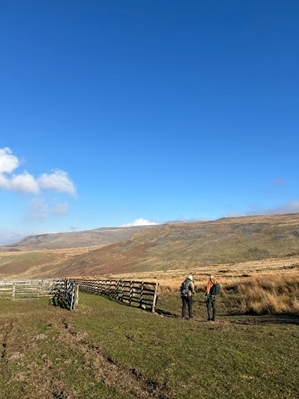By Holly Appleby, Sam Rawlinson and Molly Brown, Uplands Research
The GWCT Uplands Research team received funding from Natural England’s East of Eden Nature Recovery Project to investigate whether new native woodlands can benefit black grouse whilst minimising negative impacts on breeding waders. We identified 86 new native woodlands planted in the last 25 years close to the moorland wall and in proximity to designated areas in the Eden Valley.


For the past three months, we’ve been heading out to these new native woodlands, looking for black grouse. This has involved long hikes, up to 15km per day, in occasionally challenging weather. The North Pennine slopes can be a bit treacherous, therefore care is taken to avoid slips, trips and wet feet. Despite the rough terrain, we’ve all agreed that we live and work in a beautiful place and the fieldwork is an amazing opportunity to get out and explore.
 When we started in January, we had a good dumping of snow, which lasted a whole week due to the cold conditions. The hills were white, and in some places, we were trudging through shin-deep coatings. Despite all the layers and flasks needed to stay warm, it was definitely worth the effort. We saw more black grouse using the woodlands in a week of snow than we’ve seen since.
When we started in January, we had a good dumping of snow, which lasted a whole week due to the cold conditions. The hills were white, and in some places, we were trudging through shin-deep coatings. Despite all the layers and flasks needed to stay warm, it was definitely worth the effort. We saw more black grouse using the woodlands in a week of snow than we’ve seen since.
The grouse seem to prefer sticking to their home ranges, so there are a lot of woodlands where we have not seen any. Even without them, we still see hares darting on the hillsides, flush woodcocks from the scrub or noted buzzards circling above.
 Spring has well and truly arrived over the last few weeks. The hillsides are a lot noisier with the return of curlew and lapwing. The black grouse are less in need of shelter with the weather cheering up, so sightings in the woodlands have dropped off, but there’s plenty of other animals to distract us whilst we’re out.
Spring has well and truly arrived over the last few weeks. The hillsides are a lot noisier with the return of curlew and lapwing. The black grouse are less in need of shelter with the weather cheering up, so sightings in the woodlands have dropped off, but there’s plenty of other animals to distract us whilst we’re out.
Now that the breeding season has begun, we will start our lek counts (surveys of black grouse males displaying at dawn). From mid-April until mid-June we will also return to the new native woodland areas to conduct wader transects to investigate whether the woodlands impact on the number and distribution of breeding waders. We’re going to be very busy, so fingers crossed for some good weather!